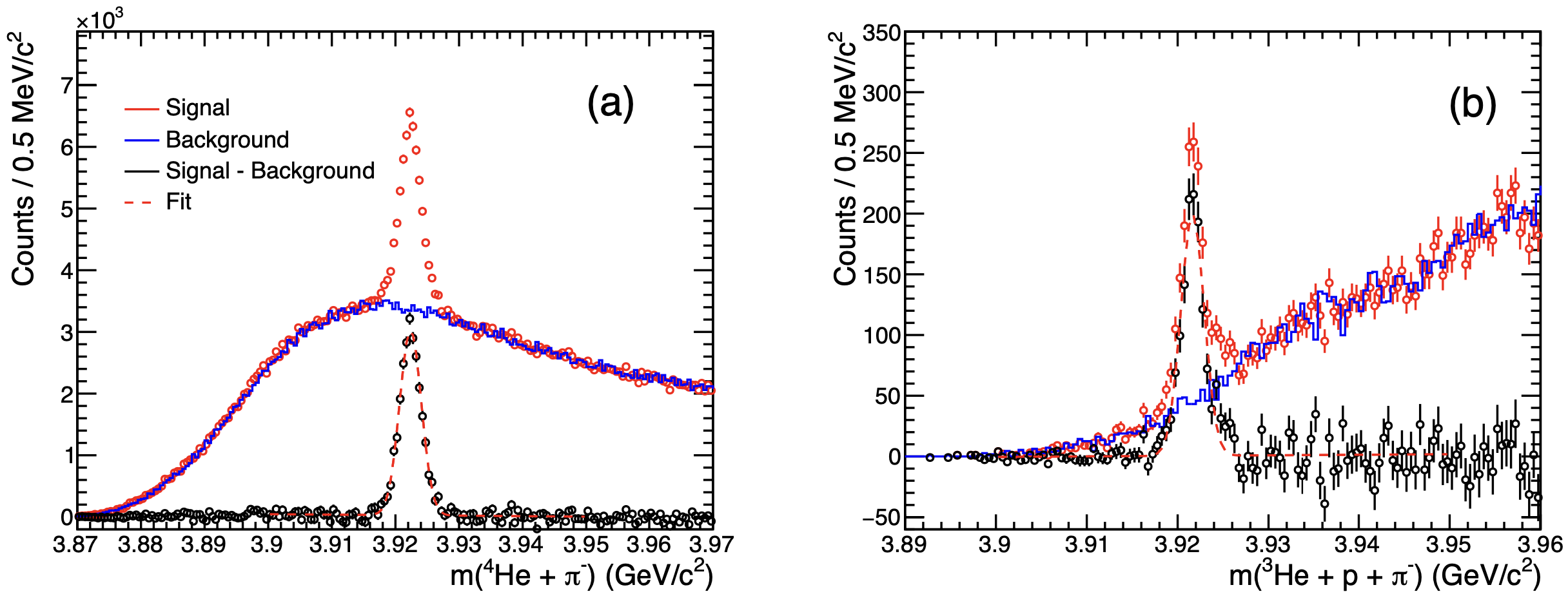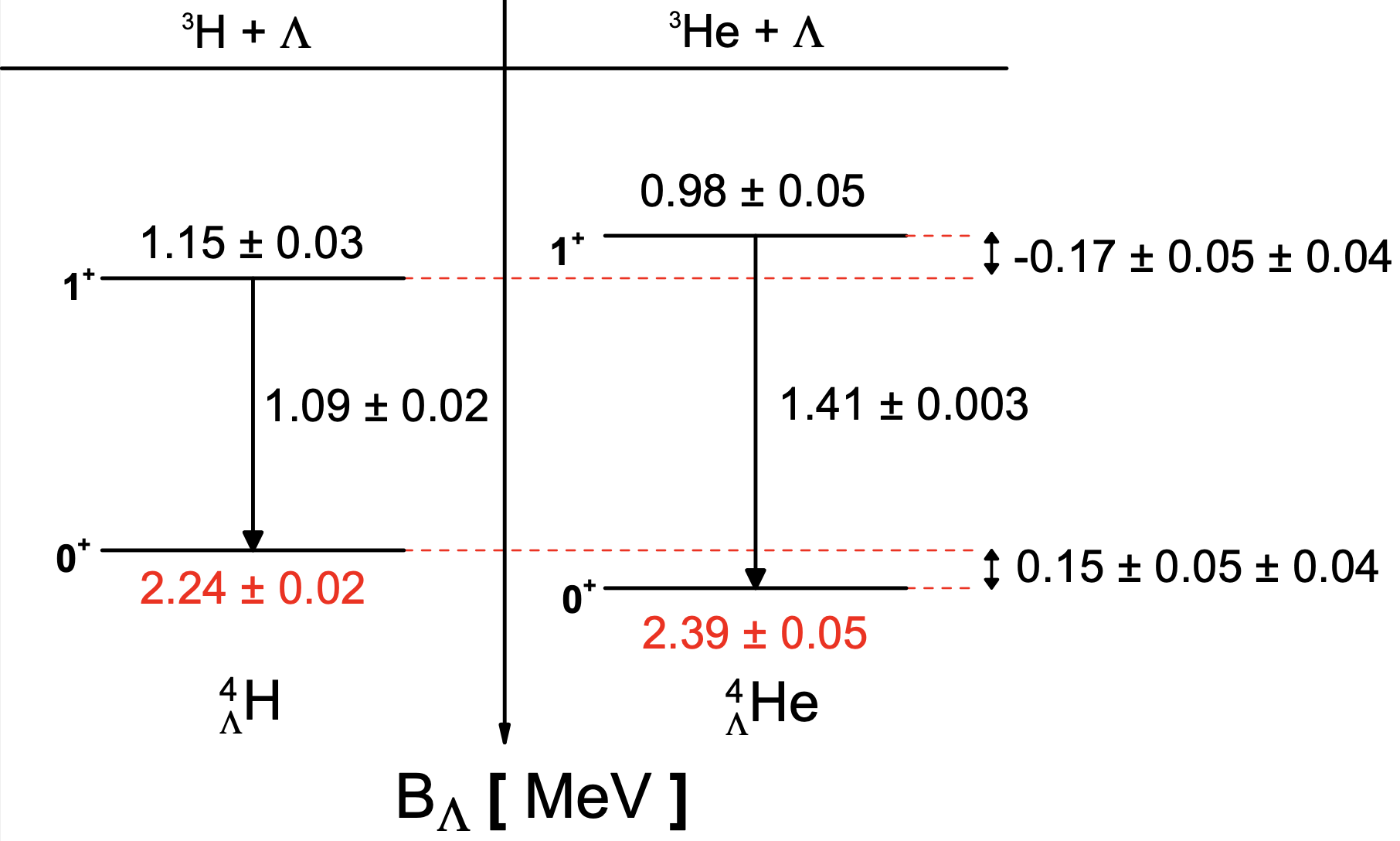Measurement of Charge Symmetry Breaking in A = 4 hypernuclei in 3GeV Au+Au collisions at RHIC
Title:
Measurement of Charge Symmetry Breaking in A = 4 hypernuclei in Au+Au collisions at 3GeV at RHIC-STAR
PAs:
Jinhui Chen, Yu-gang Ma, Tianhao Shao, Zhangbu Xu
Target journal:
Nature Physics / Physical Review Letters
Abstract:
To test the charge dependence of Λ-nucleon (ΛN) interaction, which is called the charge symmetry of nuclear force, the Λ binding energies of mirror hypernuclei with nuclei number A = 4, H4L and He4L, are measured with a high precision in Au+Au collisions at 3GeV with the RHIC-STAR experiment. The measured results are BΛ(H4L) = 2.24 ± 0.02(stat.) ± 0.05(syst.) MeV and BΛ(He4L) = 2.39 ± 0.05(stat.) ± 0.04(syst.) MeV for the ground states of H4L and He4L, respectively. The Λ binding energy difference between them, which refelcts the charge symmetry breaking (CSB) of ΛN interaction, is measured to be 0.15 ± 0.05(stat.) ± 0.04(syst.) MeV for ground states. Combined with the transition energies of γ-rays from their excited states, the difference in excited states is determined to be -0.17 ± 0.05(stat.) ± 0.04(syst.) MeV. These new results are the most precise measurement of CSB in A = 4 hypernuclear system so far and confirm that the Λ binding energy differences in their ground and excited states have compareable magnitudes and opposite signs.
Conclusions:
In summary, with a large statistics of data in Au+Au collisions at 3 GeV recorded by the STAR detector, the masses and Λ binding energies of the ground-state H4L and He4L are measured with a high precision in the same experiment. The results of their excited states are also obtained by using the γ-ray transition energies from previous measurements. Our work achieves the most precise measurement of the Λ binding energy differences in ground and excited states of the A = 4 hypernucler system so far to address the CSB puzzle showing in ΛN interaction. The difference in excited states is confirmed to be negative with a magnitude compareable to which in ground states. Our measurements provide stringent constraints on ΛN interaction, nuclear structure models, and strange matters such as neutron stars.
Figure 1. The reconstructed invariant mass distributions of H4L (a) and He4L (b). The red circles and blue histograms represent the signal and the rotated background, respectively. The black circles represent the pure singal obtained by subtracting the background from the signal distribution. The red dashed curves show the fits to the pure signal distribution with a Gaussian function plus a linear function to describe the signal and the residual background.

Figure 2. Energy level schemes in terms of Λ binding energies of H4L and He4L. The values of ground states are from this measurement while the ones of excited states are calculated according to the γ-ray transition energies from previous experiments.

Figure 3. The Λ binding energy differences between H4L and He4L in their ground states (a) and excited states (b). The red and blue stars represent the results from this measurement and the previous work using the STAR 2018 data, respectively, while the error bars show their statistical uncertainties and boxes show the systematic uncertainties. The blue squares represent the previous measurement from other experiments and the boxes show their total uncertainties. The black dots represent the calculation results with different theoretical models and the error bars show the uncertainties of the theory.
.png)
Previous PWG presentations :
drupal.star.bnl.gov/STAR/system/files/Tianhao-20250714-hypernuclei.pdf
drupal.star.bnl.gov/STAR/system/files/Tianhao-20250512-hypernuclei.pdf
drupal.star.bnl.gov/STAR/system/files/Tianhao-20241022-Collaboration-meeting-hypernuclei.pdf
drupal.star.bnl.gov/STAR/system/files/Tianhao-20240902-hypernuclei.pdf
Previous work:
doi.org/10.1016/j.physletb.2022.137449
- shaoth's blog
- Login or register to post comments
